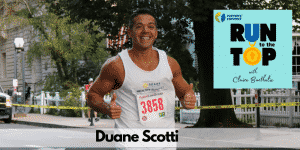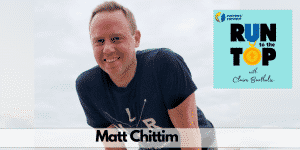Physical Therapist, Brad Beer, returns to discuss injuries, rehab, and listening to your pain.
This was a great opportunity to sit down with Brad and chat about such an important topic for all runners. Listeners will get some great information on how to assess your pain; when it’s time to take a break and structure an off-season; and pacing yourself on the road to recovery.
Being a runner himself, Brad understands not only thephysiological aspect of injury, but the emotional and psychological effects ofhaving to sit out races. As such, he has become one of the most sought afterpractitioners in his field.
Join us as we have a fun, casual chat about a relatively serious topic.
Today’s topics include:
- How to assess your pain and know when to take a break
- Traits to look for in a medical professional
- The Boston Marathon and how to emotionally and physically handle the stress of missing out on races
- Activating your glutes
- How to strengthen your quads
- Pacing yourself for recovery
- Structuring an off-season
- The most important step on the road to recovery
- The best advice Brad ever received and his best advice for new runners
Questions Brad is asked
- What have you been up to since we last talked on the first interview (2:00)
- How is You Can Run Pain Free doing as a book? (6:00)
- When it comes to pain, how do you know which pains to run through, and which pains to stop right away? (7:30)
- Does that advice apply to every kind of pain, or does sharp pain, dull pain, aching pain require the same treatment? (10:00)
- What if the pain starts as a 5/10 but eases off after a few minutes? (11:15)
- What if you feel okay during the run, but later that day or the next day it is pretty sore? (12:00)
- Thoughts on cross training? Is it better to completely rest to focus on recovery or is it better to go by pain? (13:30)
- If runners have a pain they know in their heart, know in their gut something is not right, should they take a day off as a precautionary measure? (15:30)
- How do you know when it is time to try running again? (18:00)
- What traits should you look for in a medical professional who you can trust? (20:00)
- How do you recommend runners fight through phantom pain paranoia? (22:30)
- How do you get over the emotional aspect of sitting out a race when everyone around you is celebrating? (27:00)
- What if you live in a place where there are not many other runners or professionals who understand the frustration or injuries? (30:00)
- How should runners deal with runner blues after a big race? (33:00)
- How do you get your glutes to fire? (37:00)
- How can you prepare your quads for downhill racing? (40:00)
- Easy running: How can runners pace themselves to make sure they recover (42:30) and make sure they are running easy enough? (43:30)
- Are you a big fan of runners peaking or does running year round do any harm? (45:00)
- Are there any questions that you often get about injuries that you would like to help runners with? (47:30)
- Brad talks about running shoes
- Running form/technique, what is most important to fix?
- How do you stop overstriding and improve cadence when running? (50:00)
[bctt tweet=”The ultimate injury podcast for runners. How to know what to do!”]
Quotes
“There’s a distinction between the pain of injury and the pain of exertion.”
“We often miss those moments to celebrate and then goon to the next one.”
“Pain is your ally; not your enemy.”
“If the pain gets to more than a 3 out of 10 on a self reported scale, (10 being the worst, 0 being worst) go gently, if it gets to be more than a 5 out of 10, your body is saying, right now I’m not happy to be running. At that point, I would recommend having a day off, having two days off.”
“If after 2-3 days that niggle or pain is still there, then it is worth consulting your local professional”
“Your body is still saying, right now, I do not feel very good, so pushing on, and ignoring that without some intervention can only go one way, and that is down a southward trail”
“Pain is a signal our bodies experience, and we need to take heed of it”
“We like to bury our heads in the sand and pretend its not there, push through it, but doing that too long in succession means a little pain becomes something that becomes a bigger pain that frustrates us, costs more money”
“Your gut will scream out, the intuition is there”
“Experience itself is not a great teacher, but an evaluated experience is a great teacher”
“I am not my running, there is more to me than my running”
“Count one minute of your running every five minutes. Pick a leg, and count how many times that foot hits the ground in a minute of running. If it is less than 90 steps in a minute, as a guide, then it is likely to fit into the category of overstriding”
“A 10% increase in cadence will markedly improve performance and decrease injury risk”
We really hope you’ve enjoyed this episode of Run to the Top. Please consider giving us a review on iTunes by clicking THIS link. You can follow this YouTube Video of a Demonstration of How to Leave a Review. Thank you in advance.
Take a Listen on Your Next Run
Or download the Full Audio MP3 to listen to on any device (Android and Windows) on your next run.
![]() Want more awesome interviews and advice? Subscribe to our iTunes channel
Want more awesome interviews and advice? Subscribe to our iTunes channel
![]() You can also download directly to your Stitcher Radio app
You can also download directly to your Stitcher Radio app
Links and resources:
Previous interview with Brad Beer
Enter to be one of 5 WINNERS of Brad’s Book “You Can Run Pain Free”
Enter to win a FREE set of headphones from our sponsor, Jabra
Queensland Gold Coast marathon
Should you run or rest? Single leg hop test
How to activate your glutes with a wall push
How to structure your training for long-term improvement
How to Plan a 1-2 Year Cycle to PR in Every Distance
Brad’s favorite book; Ordering Your Private World
Brad’s favorite running book: Born to Run by Christopher McDougall (also listen to our podcast episode with Christopher!)
Brad’s Brand New Podcast: The Physical Performance Show









